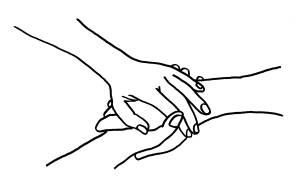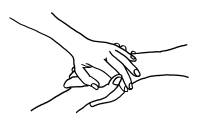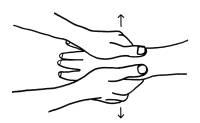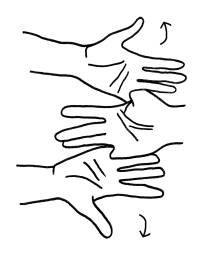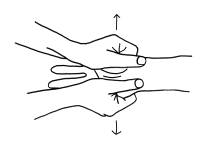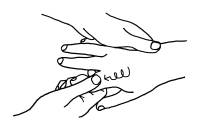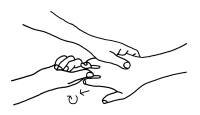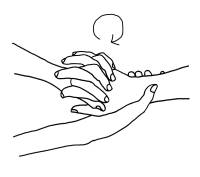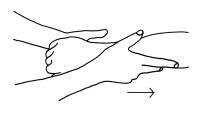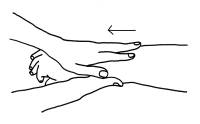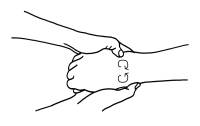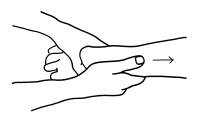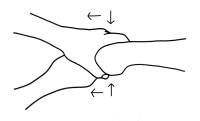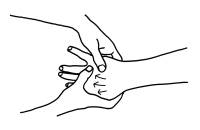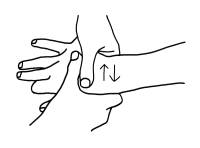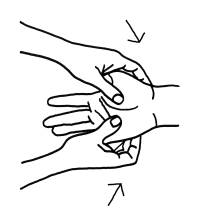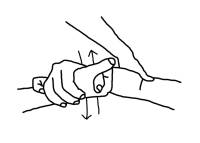Table of Contents
MÃOZADA - The Handshake : A hands massage manual
We are happy to share a manual we have created for everyone to enjoy simple yet powerful hands massage. Scroll down for all our detailed suggestions and/or get the manual in pdf, ready for printing !
You are free to print, copy, circulate, and remix as you please. Do not, however, make any commercial use of this work in whole or part. It was conceived as a gift; please use it as such.
Love to our friends and to all those yet-strangers who will become friends after a good handshake!
<3 !!
Before your massage
Before your start your massage please visit the General advice for massage page. Evaluate whether there are contra-indications to giving/receiving massage for any of you, and become aware of any precautions you should take, depending on your health, settings, etc.
Our Hands
Our hands are tools; they transform thought into action, shape our reality, connect us to the world and the beautiful beings that are part of it.
An extension of our hearts, they can bring the ones we love closer, and keep at a distance those we distrust.
Their sophisticated anatomy enables both the use of brute force and the most delicate of gestures.They feed us, defend us, but also hold onto a lot of stress.
As the bark of the tree, the skin of our hands holds the traces of the many stories that make up our lives.
Since all body parts tend to reflect a greater whole, a hand massage will have positive effects on the general state of being.
Here are some suggestions and tips on how to provide nice hand massages to friends: after all, this is one of the easiest massages to give on the go!
Getting ready for massage
Setting
Find the appropriate space and time for your massage. Ask not to be disturbed. Make sure neither of you will have to rush anywhere afterwards.
Switch off your mobile phones and laptops; take off your jewelry. Both of you should then wash your hands; ideally you should have short, clean nails.
You can quickly warm up your hands before you start!
Your emotional state is just as important as your physical surroundings. Receiver and Giver, please take a moment to notice how you are feeling before starting. Are you having a good day? Are you nervous? Tired? Upset about something, and pretending not to be? Acknowledging your own emotions before receiving or giving a massage will help you find the right, comfortable place to be with yourself and the other. You will be aware of your limits and, most importantly, you will be able to avoid mistaking your emotions for your friend's and vice versa; this will contribute to a successful, pleasant experience for you both.
Good posture
Find a comfortable position. There are different setups you can choose from:
The "Beauty Salon"
Sit in front of each other across a table. This option requires the least intimate contact giver and receiver (hence more timid persons can feel more comfortable), and is perfect for casual chit-chat. For more comfort, you can use a rolled towel as a wrist rest for the receiver.
The "Tea House"
Sit on floor cushions, facing each other without being perfectly level, so that your opposed shoulders, rather than your faces, are aligned; this way, you won't have to twist your back during the massage. Your opposed knees fall between each others' legs. For the receiver's comfort, and to spare them the temptation to hold their arm and hand up in the air during the massage, you can place a large cushion under their armpit and under their forearm. If you are going to be using oils later, do not forget to protect your cushions and clothes with a towel.
The "Flying Carpet"
The receiver is lying down. The giver sits by their side, facing the opposite direction (that is, facing the hand they will be working on). This position is very relaxing for the receiver, since their muscles can rest; however, you may have to help them keep their arm and hands relaxed throughout the massage. This can be achieved with the appropriate use of props (cushions, rolled towels) and by using your − firm yet delicate − grip to support their articulation whenever you wish to move them. Indeed, movement is initiated at the joints (shoulders, elbows, wrists). If you keep your friend's articulations “safe”, the receiver will “follow” your massage rather than resist it, which will be more relaxing for them and more enjoyable for you. When lying down on their back, some people immediately feel pain in their lumbar region, and eventually everyone will feel some discomfort after a while. To prevent or alleviate the pain, place big enough cushions or rolled towels under both the receiver's knees, or suggest that they bend them (the sole of their feet stays flat on the floor). The idea here is to minimize the lumbar curve of the spine, thereby releasing undesired tensions.
A Snake-like Spine
You want to find and keep a good sitting posture. The most important thing to take care of is your spine. Look at the natural curves of the spine in an anatomy book; this “S” is what we want to protect. Often, due to a lack of flexibility and poor habits, we slouch and slump, hence we lose our vitality and tire more quickly.
To restore the S shape of your spine, respect the following:
Whether on a chair or on the floor, sit on you sitting bones (called the Ischium, the lower back part of your big hip bone). Make sure you knees are at a lower level than that of your hips; this will slightly tilt your pelvis and impart the right curve to your lumbar region. The curve should be subtle, so don't exaggerate!
If while sitting on the floor, for example in a lotus position, you have difficulty keeping your knees lower than your hips, place a cushion under your bottom, and only just sit at its edge. This will help you keep a comfortable curvature in the lower spine. This way of sitting is also know as “zafu sitting”.
Once you've got the basics right, the rest of your spine will follow. Ultimately, you should always think of your posture as something dynamic, like a cobra doing an hypnotic dance. You may be focussed, but you should never be completely still. Remember that both of you are “allowed” to move, adjust, change posture during the session, whenever a given position becomes uncomfortable.
Precautions and Contraindications
Before the session, take a moment together to consider possible precautions (where you should exert caution) and contraindications (where you should not massage). You can consult the list below.
Ask your friend a few very basic questions, starting from more general questions like “HOW DO YOU FEEL TODAY?”, “Do you feel any pain?” to then move to more specific ones, focussing in on the hand and arm. Regarding possible illnesses, be as little intrusive as possible. Inviting your friend to read the list of contraindications can be a good alternative to direct questioning, and will be more considerate with regards to their privacy.
Also, use your common sense: What do you see? Are there any bruises, cuts, signs of a rash on their hands and arms? Does the skin look fragile? Are there any signs that might point to your friend having a fever? You might have to avoid a particular spot on your friend's hand or arm, or keep a very light pressure throughout the whole sequence (even if otherwise indicated in this manual!), or to avoid any massage altogether for now.
In any case, do not improvise yourself a therapist, and always make sure the dialogue is open between you two, so that your friend will feel comfortable providing your with feedback as you proceed. Always keep feeling, and adjust your movements in real time in response to the “information” you pick up; this way, the massage will be adapted to your friend's needs and condition.
See also:
Special precautions for a hand massage
- Pregnancy. Keep a light touch (nothing that would startle the person), do not increase pressure, and especially avoid Chinese acupressure point HEGU (LI 4, located between the thumb and index) which is traditionally used in Chinese medicine to induce labor.
- Acute carpal tunnel syndrome. If untrained, you can massage very gently if and when the pain is not severe. In case of acute pain, you'd better refer your friend to someone qualified.
- Contagious parasitic skin infections (such as scabies, in which case you could maybe notice signs of rash between the fingers). This is an absolute no-go. If your friend has a dermatological condition which is not contagious (many aren't) they will probably know, and tell you it is not contagious.
- Open wounds, sores.
- Fractures, recent surgery or injuries to the hand or arm.
Intentions: What do you wish to get out of this massage ?
Once you are both ready, start by holding hands. Connect, acknowledge and enjoy each other's presence. As massage therapist Ann Catlin puts it in her article Connecting and expressing a language of the human heart:
“Center yourself and take a cleansing breath to focus your attention and intention. Take a moment to establish trust with the [other] and gain permission to provide the massage. Sit facing the person, to the side. Be sure that you can reach the shoulder area without strain. (…) Begin with focused touch; simply hold the person’s hand. Place your attention on their hand and think about all the ways their hands have served their life. Notice the lines, the elegance, the strength or the fragility, whatever is there. Linger here a moment, simply enjoying the connection.”
Ask your friend what they wish to get out of this massage. Invite them to express their wish (it could be to ease pain, relax, stop worrying, feel loved, etc). Defining an intention together, even a simple one (actually, the simpler the better), sets the massage on a good path, and helps you bond and build trust. It can also be an opportunity for your friend to express something important, an emotion, a state of mind, in the comfort of your presence. Whatever comes, welcome it. You don't need to have an opinion, nor do you have to have something reassuring to say. Having a nice moment together, welcoming your friends words and feelings is all that matters.
And you, do you know what you want to achieve with this massage? Again, the simpler and humbler the goal, the better (for example, I want to help my friend relax). Don't, for example, insist on wanting to be some sort of “savior”.
What if your friend wishes for something that seems completely out of reach, like, “I want peace in this world”? Well, aren't you about to experience a moment of peace, in this world, together?
Trust your hearts, and share the experience.
MAOZADA : A suggested sequence for hand massage
The sequence presented here is a simple suggestion. There is no need to be orthodox about it. As a general tip, remember it is nicer, and it makes more sense, to start a massage with soft, superficial, all encompassing warm-up movements, then go into deeper, more precise, more localised techniques, then back to superficial movements before the end. Other than that, movements can come in whichever order you prefer. They can be (re)mixed, including with movements you'll make up as you go; it's a matter of going with the flow. For that, ground yourself in feeling, in the actual sensations, and dance the little dance of freestyle.
It can be nice to have an opening part without oils, because the sensations and pace are quite different. It is a good way to get to know your grounds, and good preparation for further work. Later, when essential oils are added, you can repeat all that you did in the opening part, this time appreciating the difference in feelings, and playing with the new velocity and rhythm imparted by the oils.
Looking up a bit of anatomy of the hand before you start can help a great deal, but it could also confuse you and make you feel more stressed; so just do as you feel like. You can always come back to the books later, and find it is actually easier for you to learn after practice.
In the meantime, your friend's hand is here under your eyes and under the pad of your fingers, to guide you; moreover, you happen to have hands too, so you should know what they feel, and your friend is not a dummy and can give you feedback on how you progress; trust that you can already do very well as an amateur. You'll be surprised!
ENJOY!
Part 1, without oils
As preparatory work for part 2 with oils, or as a stand-alone massage.
Hold Hands (THE HANDSHAKE)
Open the back of the hand and wrist
With your thumbs (with the tips as well as with the group of muscles at their base, called the thenar eminences), apply pressure sliding sideways from the center of the back of the hand. Don't be afraid to squeeze a bit and apply stronger pressure, so that the back of the hand and wrist will “open” and get a good stretch.
Open the palm and wrist
Turn you friend's hand, palm upward. Interlock your pinkies with their thumb and pinky, as shown on the first drawing. Locked in that position, open wide the palm of their hand, and as before, apply pressure with your thumbs, sliding away from the center of the palm. Look for a nice, intense stretch.
"COUNT MONEY" ON THE PHALANGES
The phalanges are the little bones that make up your fingers. The movement here is similar to that of “counting money”, that is, of rubbing coins between the pulp of your fingers. In this technique, we seek contact with the bones themselves, so alternatively, you can try and count your friends phalanges from the base of each finger down to the tip. As you proceed, you will rid your friend's fingers of their stress load.
Pull and rotate the fingers
Stretch the fingers
Rotate the wrist
Secure your friend's wrist in one of your hands. Interlock your fingers with theirs with the other. Rotate their wrist.
Start with slow, small-range rotations. Always respect your friend's flexibility.
You can stop the massage here, or continue to part 2, with oils.
If you stop here, go back to step 1, holding hands. Go to section 3.2.10 for indications on how to end the sessions.
Does your friend want you to continue the massage with oils now? If yes, make sure that they are not allergic to any of the oils' components. If you haven't yet done so, protect clothes and cushions with a towel.
Part 2, with oils
Pure, cold-pressed, organic vegetable oils are preferable to mineral ones. They will nourish the skin. Oils commonly used in massage therapy are almond, sesame, jojoba, apricot, and sunflower. They can be mixed with aromatic essential oils, which provide them with extra therapeutic qualities, and whose scents can aid relaxation. However, these can be expensive.
Alternatively, you can use olive oil from your kitchen, if you don't mind its rich smell. Another affordable alternative is grape-seed oil, which doesn't really have any odour at all.
If you have a bottle of essential oils, such as lavender oil, you can add a few drops of that to the vegetable oil of your choice (essential oils are always diluted in vegetable oils for massage). Before you do, remember to ask your friend if they actually enjoy the scent (have them smell it beforehand).
As a precaution, you will not use essential oils if your friend is pregnant or lactating.
Light massage of hand and forearm
Apply oils uniformly to the whole region of the hand and forearm. One of your hands secures your friend's wrist, the other gently strokes up and down the arm and forearm. The contact is smooth, sensuous, superficial. Tip: Use different paths for the way up and the way down!
Circles around the wrist joint
With the pad of your thumbs, draw circles around the heads of the Ulna and Radius, the two long forearm bones, that together with the shorter bones of the hand (carpals) make up the articulation of the wrist.
Thumb Slide (up into the forearm's muscles
Secure your friend's hand with one hand, and with the thumb of your other hand slide all the way up the back side of the forearm (the hairy side), deep into the extensor muscles, towards the elbow. Natural ridges between the muscles will guide your way. Adapt your pressure to your friend's taste. The movement is unidirectional, upwards. You can mark a pause and lighten, or increase, the pressure a little bit when you encounter a sore spot. Find another, smoother way back down to the hand, or lift off and start from the bottom again. Repeat a couple of times.
The "Boa Constrictor"
Slowly but surely squeeze your friend's forearm from their elbow down to their hand and out, with a strong, enveloping, tube-like grip, as if your hand were a boa constrictor's mouth. Go all the way down to the fingers, squeezing them together, to end the movement.
"Thumb Skate" (between metacarpal bones on the back of the hand)
With both thumbs working alternatively (a bit like skating), slide rapidly up and down between the bones on the back of your friend's hand (called the metacarpals).
"Thumb saw"
Both your thumbs criss-cross rapidly across the back of your friend's hand, as if you were “sawing” their tendons (the less vascularized tendons are “tougher” than muscles, they'll like this!)
Palm Massage
Turn your friend's hand, palm upward. Secure and open their hand into yours using your pinkies as before. With the pad of your thumbs, press and slide down the palm, drawing lines that follow the direction of fingers. You can also “walk” the palm with the tip of your thumbs, pressing, like a cat, or stop and draw circles in the center of the palm.
Drain the "valley of the thumb"
Between the index and the thumb lies a bunch of strong muscles; indeed there are 8 muscles that are responsible for the thumb's movements only! This region is often tense and sore. In classical Chinese medicine, this is where the acupuncture point HEGU is located (“Joining valley” is point 4 on the Large Intestine meridian). It is advised that you avoid working on this area if your friend is pregnant. You can proceed in different ways, which might come to you intuitively. One such way is to pinch these tough and tired muscles between your thumb and folded index, and to “drain the strains”, away from the hand.
Swing arm
Get hold of your friend's hand and gently swing their arm to the sides (their arm should be bent), sending nice waves of relaxation all the way up to their shoulder. If you feel them “resisting”, you can use your other hand to gently squeeze their elbow, so they will give in more easily. You can also softly massage their shoulder while swinging. Tip: Sometimes, when someone is “resisting” relaxation, not letting go of their vigilance and tension (make sure this is not due to pain you're accidentally causing), the answer does not necessarily lie in using a gentler touch; on the contrary, it lies in using firmer movements. Indeed this creates a feeling of greater safety, it indicates a full(er) presence and more confidence on your part, thus helping your friend relax.
Closing the session : Hold hands
The massage is nearing its end. Hold hands again. You are now back to where your session started. Only things aren't quite the same, are they? Don't rush out of the massage. Feel the difference between now and the start. When you feel ready, tell your friend the massage is over. Gently check on them, ask how they feel. But careful: now is not a time for extensive feedback. Give your friend time, leave them alone to rest while you go wash your hands and prepare tea − and actually tell them this is what you'll be doing, so that they won't feel “abandoned”.
Then as the two of you share a cup of tea, exchange a few words about the massage if you want to. Never, however, insist that your friend give you feedback on how the session was for them. They will, if they want to. Thank each other for the gift of this moment. One last thing: maybe you had agreed, prior to the session, that your friend would provide a massage in return. Maybe they still feel like it, maybe they don't. If they don't, you will have to accept this :) Now that this manual has been circulated, you are bound to meet someone who will give you a hand massage really soon in any case, right?
Credits and Terms of use
Mãozada − The Handshake was redacted in Portugal, in 2015.
Design and texts are by Emily King.
Drawings are by Dayana Lucas.
Special thanks to La Quadrature du Net, Sarah Hiltner, and everyone who helped in the making of this manual <3 !
You are free (and invited) to print, copy, circulate, and remix as you please - as long as :
- You do not make any commercial use of this work in whole or part.
- You mention its origin/authors,
- You keep the same standards for sharing as we
Love to our friends and to all those yet-strangers who will become friends after a good handshake!
More Resources
Videos
Basic oriental techniques (as found in thai or japanese massage) for opening of palms and wrists. Key moves ! The person receiving massage is lying dow on a futon on the floor. No oils needed.
- Basic arm and hand massage by homespa beauty
Nice tutorial for basic hand and forearm massage with oils or cream, sitting face to face at a table (beauty salon set up). Easy, lovely moves, smoothly executed and described. Good standards for care (clear instructions for set up, remarks on hygiene and health precautions). Observe how she warmly secures the person's hand in hers when she needs to turn it.
Anatomy
- Hand and arm anatomy browser American Society for the Surgery of the hand


